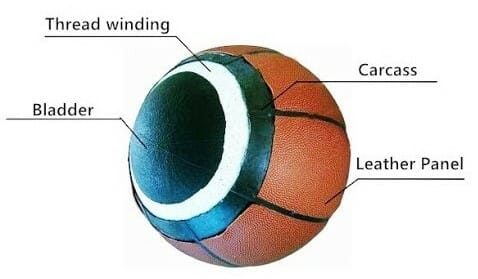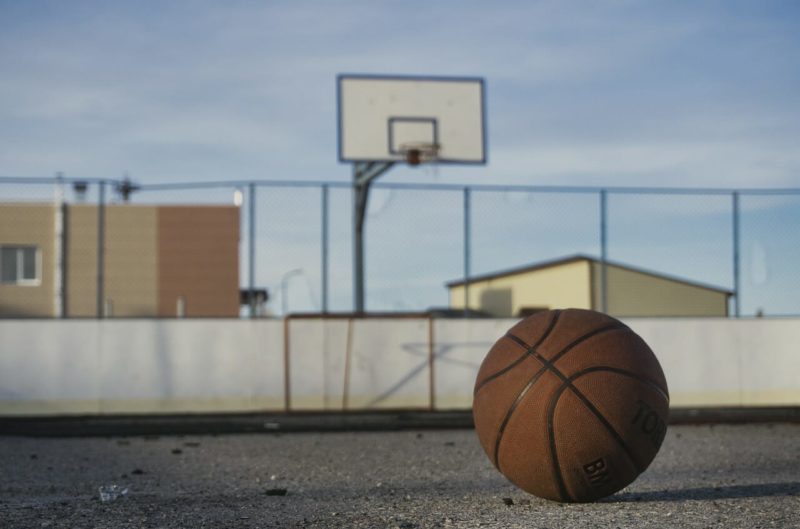Have you ever wondered what is inside of a basketball? What parts are used to compose it? In this article, we will take a look inside a basketball and see what’s in it.
The inner parts of a basketball
There are 5 main things that are included in a basketball. They are:
- the carcass
- the thread winding
- the bladder
- the valve
- air (of course… )
Let’s take a closer look at each one.

The carcass of a basketball
The carcass sits just below the outside layer of the ball and it is made of polyester. If you “peel” the original leather, rubber, or composite leather outside of a basketball, you will see the carcass.
The main purpose of the carcass is to protect the inner parts of the ball but also give the ball this nice spherical shape. Polyester threads are placed around the ball along with nylon threads (the thread winding). When both polyester and nylon threads are utilized inside the inner bladder, it improves the ball’s performance.
The thread winding of a basketball
The thread winding is a layer of cotton or nylon thread that is wound just below the carcass and around the bladder. This layer provides strength and support to the bladder.
The butyl rubber bladder is spherical, but it would be easily dis-shaped when the ball is bouncing, so the major role of the nylon is to keep the form intact. Carbon, nitrogen, and hydrogen are used in the production of nylon.
The bladder of a basketball
This is the heart of the basketball and is usually made of butyl rubber. This part of the ball is vital to the basketball as it retains air and gives the ball its bounce. The bladder is made of latex and it is what holds the air inside the ball. It is also what gives the ball its shape.
If the bladder gets a hole or is torn apart, then the ball cannot hold air anymore. The bladder in older balls could be patched and repaired because you could take the whole bladder out of the carcass and fix it. However this is not possible in most modern basketballs.
The valve of a basketball
The valve is a small opening that allows air to be pumped into the bladder. It is made of a plastic tube that can let the air go in (when pumped by a pump needle) but does not let it go out. The valve is a basketball part that goes all the way from the outside layer to the inner layer of a basketball.
If the valve is damaged, then your ball will not be able to hold air and you will need to get a new one, as this part of the ball is difficult to repair.
Air …
You will be surprised to know most of the inside of a basketball is covered by air! Air is what gives the ball its bounce. It is also what makes it possible for the ball to be thrown and caught.
Basketballs are usually inflated to a pressure of between seven and nine pounds per square inch. This is the air pressure inside the ball when it is new. As the ball is used, the air inside will slowly leak out and you will need to pump it up again. For more details on the air pressure for a basketball, check this post.
How to find out what is inside a basketball yourself
If you want to find out what is inside a basketball yourself, then you will have to tear it open. This means that you will damage the ball beyond the point that it can be repaired, so make sure that you do not use your most expensive basketball for this experiment. You should use a cheap outdoor basketball made from rubber instead.
To cut the ball open, use a knife, a razor or some scissors and start from a point where the carcass is thinner. The paint lines that start from the valve and go around the basketball are probably the best point to start from. Those are the points where the panels that make up the basketball are interconnected and it is easier to cut into them.
If you don’t want to damage any basketball but want to take a look inside anyway, you may view the whole process in the below video:
Conclusion
So, that is what inside a basketball! I hope you found this post interesting and informative. If you have any questions or comments, please leave them below and I will be happy to answer them. Thanks for reading!
- How to Pass a Basketball (5 effective tips) - August 25, 2022
- Learn How to Spin a Basketball on your Finger in less than 3 minutes - July 18, 2022
- Where are basketballs manufactured? (hint : mostly Asia) - June 10, 2022

